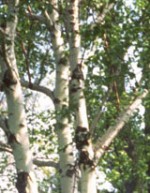 The bright white trunks with black markings of this cold weather tree are striking and very eye-catching. Used as a specimen tree or grown in clumps it brings a beautiful and romantic ambience to any garden. The young branches are reddish-brown with horizontal lenticels that create an interesting texture but in about 4 seasons the bark becomes papery and chalky white. As the tree becomes mature rough black patches appear, adding to the beauty of the tree. The white bark exfoliates in strips to expose an inner orange bark. If the bark is not enough to entice you, perhaps the foliage will; in spring and summer the simple green leaves provide light flickering shade and then in the winter turn clear bright yellow. To add a charming rustic note to your interior decor cut branches into log sized pieces and put in a black container near the fireplace. Add a red bow at Christmas, and enjoy a picture-perfect scene.
The bright white trunks with black markings of this cold weather tree are striking and very eye-catching. Used as a specimen tree or grown in clumps it brings a beautiful and romantic ambience to any garden. The young branches are reddish-brown with horizontal lenticels that create an interesting texture but in about 4 seasons the bark becomes papery and chalky white. As the tree becomes mature rough black patches appear, adding to the beauty of the tree. The white bark exfoliates in strips to expose an inner orange bark. If the bark is not enough to entice you, perhaps the foliage will; in spring and summer the simple green leaves provide light flickering shade and then in the winter turn clear bright yellow. To add a charming rustic note to your interior decor cut branches into log sized pieces and put in a black container near the fireplace. Add a red bow at Christmas, and enjoy a picture-perfect scene.
Type: Single or multi-stemmed deciduous tree.
Outstanding Features: Bright white bark; yellow fall coloration.
Form: Losely pyramidal when young; irregular oval to rounded when aged.
Growth Rate: Moderate to rapid.
Bloom: Inconspicuous flowers borne in long pendulous catkins in early spring.
Size: 50-70’ H x 25-45’ W
Light: Full sun.
Soil: Moist, well drained slightly acid sandy soil but tolerates less.
Hardiness: Zones 2-6.
Pests and Diseases: Somewhat borer resistant.
Propagation: Seed; cuttings can be difficult.
Comments: Easy to transplant; not resistant to pollution; short lived; do not plant near walnut as it exudes a substance into the soil that is toxic to paper birch.
